Lamna nasus Bonnaterre, 1788
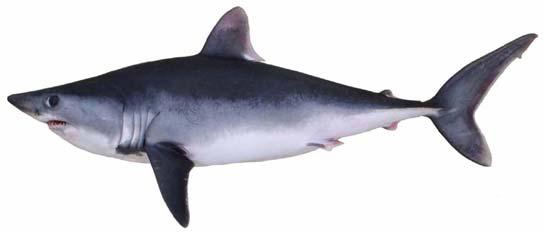
Phylum: Chordata Haeckel, 1874
Subphylum: Vertebrata Lamarck J-B., 1801
Classe: Chondrichthyes Huxley, 1880
Ordine: Lamniformes Berg L.S., 1958
Famiglia: Lamnidae Müller J.P. and Henle, 1838
Genere: Lamna Cuvier, 1816
Italiano: Smeriglio
English: Beaumaris Shark, Blue Dog
Français: Maraîche, Requin-taupe commun
Deutsch: Heringshai, Kalbfisch
Español: Cailón marrajo, Marrajo
Descrizione
È considerato una delle specie più piccole dei Lamnidi. Tuttavia il suo peso si attesta intorno ai 500 kg e la sua lunghezza raggiunge i 3,6 m. I colori della specie variano dal grigio-blu al marrone con macchie bianche. È dotato di una carena secondaria, situata alla base della coda. Diffuso nei mari freddi fino alla profondità di 370 metri, si nutre di sgombri, calamari e merluzzi; caratteristico è il fatto che, per riuscire a respirare, deve nuotare costantemente. Pesce a «sangue caldo»: grazie alla sua capacità di convertire la forza muscolare, l'attività fisica, in calore, riscalda il sangue, ottenendo una temperatura anche di una decina di gradi superiore a quella dell'ambiente esterno.
Diffusione
Oceano Atlantico, Indiano e Pacifico. Si tratta di una specie non in grave pericolo, anzi che sta conquistando nuovi areali distributivi nell’emisfero settentrionale (Atlantico). Anche se nel Mar Mediterraneo è più rara (a causa del riscaldamento delle acque).
Sinonimi
= Lamna cornubicus Gmelin, 1789 = Lamna philippii Perez Canto, 1886 = Lamna punctata Storer, 1839 = Lamna whitleyi Phillipps, 1935 = Oxyrhina daekayi Gill, 1861 = Selanonius walkeri Fleming, 1828 = Squalus cornubicus Gmelin, 1789 = Squalus cornubiensis Pennant, 1812 = Squalus monensis Shaw, 1804 = Squalus nasus Bonnaterre, 1788 = Squalus pennanti Walbaum, 1792 = Squalus selanonus Leach, 1818.
Bibliografia
–Rigby, C.L.; Barreto, R.; Carlson, J.; Fernando, D.; Fordham, S.; Francis, M.P.; Herman, K.; Jabado, R.W.; Liu, K.M.; Marshall, A.; Pacoureau, N.; Romanov, E.; Sherley, R.B.; Winker, H. (2019). "Lamna nasus". IUCN Red List of Threatened Species. 2019.
–"Appendices | CITES". cites.org.
–Roman, B. Biological Profiles: Porbeagle. Florida Museum of Natural History Ichthyology Department. Retrieved on November 12, 2009.
– Peirce, R. (2008). Sharks in British Seas. Shark Cornwall. p. 102.
–"porbeagle". Oxford English Dictionary (subscription required). Oxford University Press, draft revision June 2008.
–Bonnaterre, J.P. (1788). Tableau encyclopédique et methodique des trois règnes de la nature. Paris: Panckoucke. pp. 1-100.
–Compagno, L.J.V. (2002). Sharks of the World: An Annotated and Illustrated Catalogue of Shark Species Known to Date (Volume 2). Rome: Food and Agriculture Organization of the United Nations. pp. 121-125.
–Compagno, L.J.V. (1990). "Relationships of the megamouth shark, Megachasma pelagios (Lamniformes: Megachasmidae), with comments on its feeding habits". NOAA Technical Report NMFS-90. pp. 357-379.
–Naylor, G.J.P., A.P. Martin, E.G. Mattison and W.M. Brown (1997). "Interrelationships of lamniform sharks: testing phylogenetic hypotheses with sequence data" in Kocher, T.D. and C.A. Stepien (eds). Molecular Systematics of Fishes. Academic Press. pp. 199-218.
–Francis, M.P., L.J. Natanson and S.E. Campana (2008). "The Biology and Ecology of the Porbeagle Shark, Lamna nasus" in Camhi, M.D., E.K. Pikitch and E.A. Babcock (eds.) Sharks of the Open Ocean: Biology, Fisheries and Conservation. Blackwell Publishing. pp. 105-113.
–Martin, A.P. (1996). "Systematics of the Lamnidae and the origination time of Carcharodon carcharias inferred from the comparative analysis of mitochondrial DNA sequences" in Klimley, A.P. and D.G. Ainley (eds). Great White Sharks: The Biology of Carcharodon carcharias. Academic Press. pp. 49-53.
–Musick, J.A., M.M. Harbin and L.J.V. Compagno (2004). "Historical Zoogeography of the Selachii" in Carrier, J.C., J.A. Musick and M.R. Heithaus (eds). Biology of Sharks and Their Relatives. CRC Press. pp. 33-78.
–Mollen, F.H. (2010). "A partial rostrum of the porbeagle shark Lamna nasus (Lamniformes, Lamnidae) from the Miocene of the North Sea Basin and the taxonomic importance of rostral morphology in extinct sharks". Geological Belgica 13 (1-2): 61-76.
–Long, D.J. (March 6, 1992). "Sharks from the La Meseta Formation (Eocene), Seymour Island, Antarctic Peninsula". Journal of Vertebrate Paleontology 12 (1): pp. 11-32.
–Bourdon, J. (October 10, 2007). Lamna Cuvier 1817. The Life and Times of Long Dead Sharks.
–Purdy, R.W. and M.P. Francis (December 12, 2007). "Ontogenetic development of teeth in Lamna nasus (Bonnaterre, 1758) (Chondrichthyes: Lamnidae) and its implications for the study of fossil shark teeth". Journal of Vertebrate Paleontology 27 (4): 798-810.
–Campana, S.E., W. Joyce, L. Marks, L.J. Natanson, N.E. Kohler, C.F Jensen, J.J. Mello, H.L. Pratt (Jr) and S. Myklevoll (2002). "Population dynamics of the porbeagle in the Northwest Atlantic Ocean" Archived 2010-05-27 at the Wayback Machine. North American Journal of Fisheries Management 22: 106-121.
–Roberts, Clive; Stewart, A. L.; Struthers, Carl D.; Barker, Jeremy; Kortet, Salme; Freeborn, Michelle (2015). The fishes of New Zealand. Vol. 2. Wellington, New Zealand: Te Papa Press. p. 73.
–Froese, Rainer; Pauly, Daniel (eds.) (2010). "Lamna nasus" in FishBase.
–Campana, S.E., W. Joyce, and M. Fowler (2010). "Subtropical pupping ground for a cold-water shark". Canadian Journal of Fisheries and Aquatic Sciences 67: 769-773.
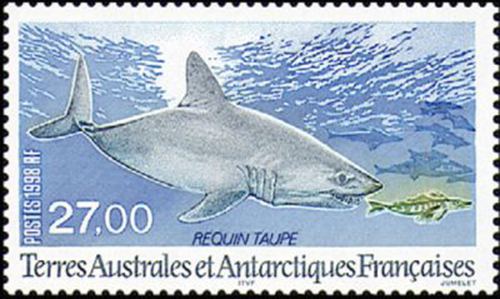
|
Data: 01/01/1998
Emissione: Fauna antartica Stato: French Southern and Antarctic Lands Nota: Emesso in una serie di 2 v. diversi |
|---|
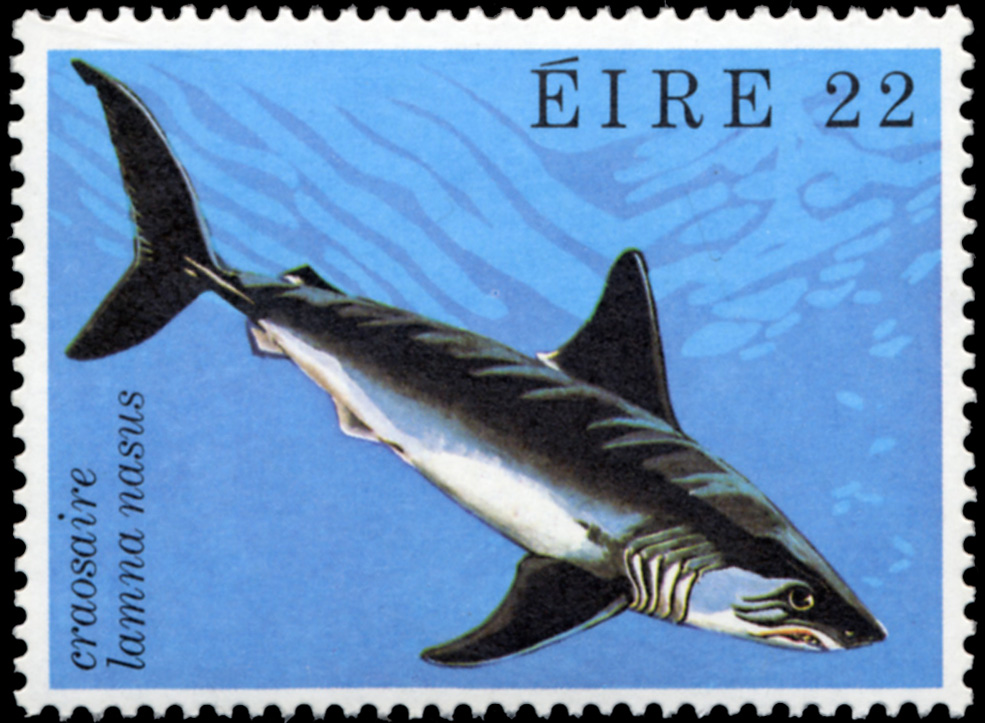
|
Stato: Ireland |
|---|
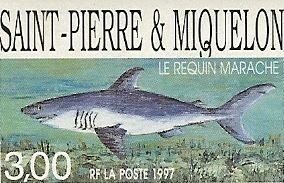
|
Stato: St. Pierre and Miquelon |
|---|
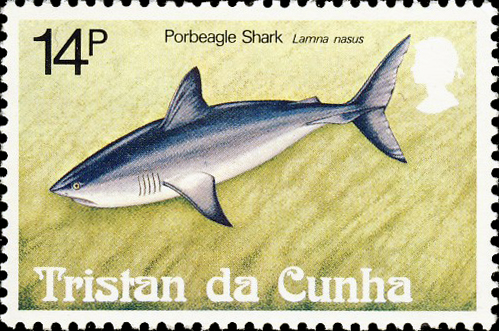
|
Stato: Tristan da Cunha |
|---|
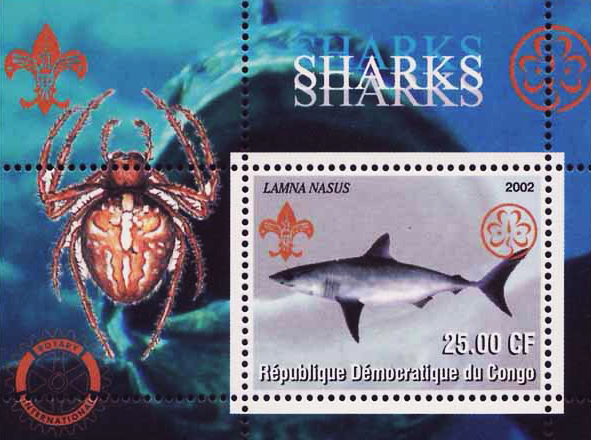
|
Data: 01/01/2002
Emissione: Ittiofauna Stato: Congo (Kinshasa) |
|---|
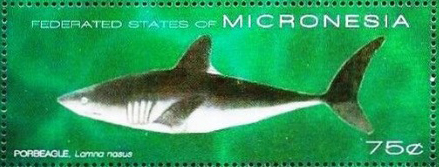
|
Data: 06/10/2011
Emissione: Squali Stato: Micronesia Nota: Emesso in un foglietto di 4 v. diversi |
|---|